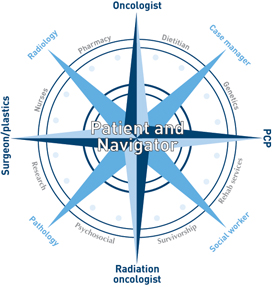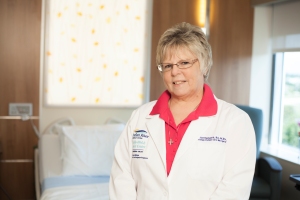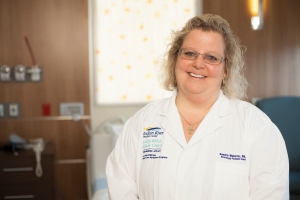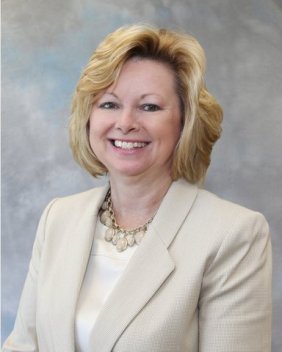THIS SIX LETTER WORD CAN LEAVE YOU STUNNED, DAZED, STUPEFIED, OR KNOCK YOU OUT. THAT WORD IS CANCER.
But, there is good news.
Imagine this situation: A 58 year old male, who lives alone and although he quit smoking 10 years ago, has noticed that he is coughing more and more, has frequent pains in his chest and over the course of the last three months has lost 15 pounds.
His mother, who lives in Palm Bay, and who helps out once a week with groceries, brings him to meet with his primary care physician. He has various tests performed and then is told he has cancer.
The next step is to meet with a surgeon, medical oncologist, and a radiation oncologist.
But he lives alone and does not have a car because he’s wheelchair bound from a previous injury. His elderly mother wants to help out but she lives in Palm Bay and probably shouldn’t be driving.
This gentleman needs help; he needs someone to help him navigate through the cancer care process; but where does he start? What does he do?
He is referred by his primary care physician to one of two Scully-Welsh Cancer Center patient care navigators, who recommend that he should come right in to the Cancer Center.
But how will he get there?
The navigator either calls the American Cancer Society in Vero Beach who has volunteer drivers to take cancer patients for treatment or the Indian River County Volunteer Ambulance Squad that provides free non-emergency transportation for ambulatory and wheelchair passengers from their places of residence to and from medical facilities throughout Indian River County.
The navigator arranges transportation for the gentleman to the Cancer Center.
The first step for the navigator is to perform a “navigational assessment.” The assessment includes a session to evaluate the patient’s situation in life. What are his symptoms? So why is he in a wheel chair? What previous treatments has he had? Does he have any support at home? What is his financial situation? Does he have health insurance?
The Scully-Welsh Cancer Center has two patient care navigators, Sandra Webster and Denise Hudspeth.
Denise Hudspeth, BA, M.DIV Sandra Webster, RN, BSN, CCM
Note: A M. DIV is a Master of Divinity / a BSN is a Bachelor of Science in Nursing and a CCM is the first nationally accredited case manager credential.
Nurse Webster’s concentration is on women and Ms. Hudspeth’s concentration is on lung screening.
When Lori McCormick joined the Scully-Welsh Cancer Center in June 2014 as Administrative Director of Oncology, one of her top priorities was “to take a look at the navigation program.” While most cancer center’s have navigator programs, “we needed to be sure ours was designed to fit the needs of the community.”
“We have a unique population,” she says. “There are those with and those without means. We needed to look at those with the greatest needs.”
Lori McCormick, BSN MSHSA
Note: BSN is Bachelor of Science Nursing / MSHSA is Master of Science Health Care Services Administration.
Thanks to the generosity of the Indian River Medical Center Foundation, Ms. McCormick was able to add an additional navigator, under the program name of the Dr. Richard Milsten Patient Care Navigator Program.
“Lung cancer is the highest cancer killer in Indian River County,” she says.
“When you have cancer, only you have it and you feel you are all alone.”
That’s where the navigators come in.
They get to know every cancer patient and connect them with resources that would other wise have been barriers to care. They guide the patient “with a heavy hand.”
Too often patients are lost in the healthcare system after screening because of missed appointments, financial problems and other barriers to timely and appropriate care.
“We oversee all these situations,” says Nurse Webster.
They sit with the patient and educate them as to what they can expect from their treatment.
They work with oncologists to oversee lung, breast, prostate, and other types of cancers diagnosis; as well as to coordinate radiation, surgery, chemotherapy and biologics.
One of the more beneficial services to cancer patients are how the navigators coordinate support groups consisting of volunteers who have had the same type of cancer as the patient; to walk them through their experiences.
All cancer patients are entitled to a second opinion. In some cases they may not feel they need one, but if the navigator believes they should have one they are able to make suggestions on who they ought to see, either locally or at a higher level.
Even if the patient does not want to be treated locally, they will help the patient to a facility where they can receive appropriate treatment for their particular situation.
One area where the cancer center shies away from is oral cavity (mouth) and oropharynx (throat) cancer. This type of cancer requires a surgical specialist which is not typically found in small communities.
The oral cavity includes the lips, the inside lining of the lips and cheeks (buccal mucosa), the teeth, the gums, the front two-thirds of the tongue, the floor of the mouth below the tongue, and the bony roof of the mouth (hard palate). The area behind the wisdom teeth (called the retro molar trigone) can be included as a part of the oral cavity, although it is often considered part of the oropharynx.
The oropharynx is the part of the throat just behind the mouth. It begins where the oral cavity stops. It includes the base of the tongue (the back third of the tongue), the soft palate (the back part of the roof of the mouth), the tonsils, and the side and back wall of the throat.
These cancers are complex and often times need a specialized multidisciplinary team assessment. “In these cases we will refer the patient to a facility that specializes in this cancer.”
Nurse Webster says she is working on an active census of approximately 70 patients. Depending on their condition, she calls about half of them every one to two weeks. If she reaches an answering machine, she leaves a message for them to call back; but only if they feel the need to.
In conclusion, she says, “We are the care continuum family so our patient never has to feel alone.”



